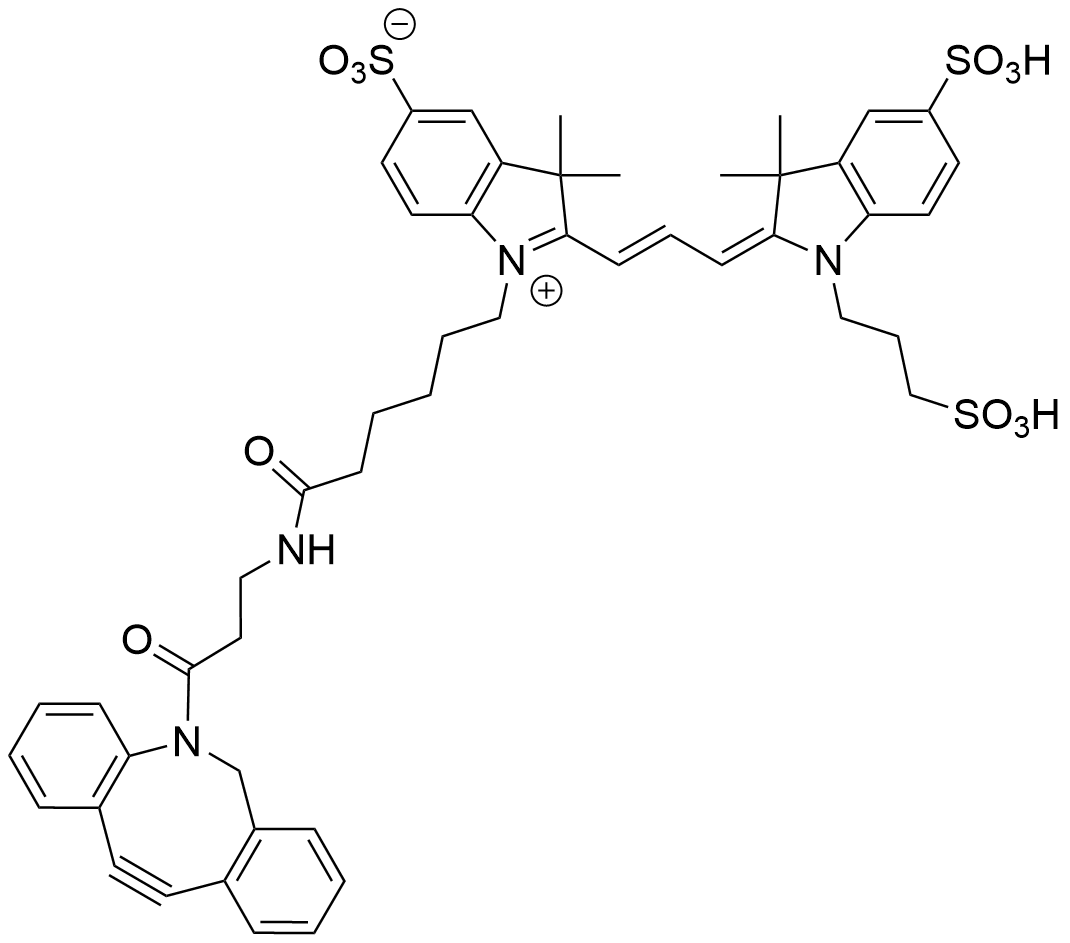Cy3 DBCO
Abs/Em Maxima: 553/569 nm
Extinction Coefficient: 150,000
Flow Cytometry Laser Line: 532, 555 or 568 nm
Microscopy Laser Line: 532 or 555 nm
Spectrally Similar Dyes: Alexa Fluor? 555, Atto? 555, CF? 555 Dye, DyLight?549

Cy3 DBCO is an azide reactive probe used for imaging azide-tagged biomolecules via a copper-free “click reaction”. DBCO moiety reacts with azides to form a stable triazole and does not require Cu-catalyst or elevated temperatures. This red fluorescent probe is water-soluble, and its fluorescence is pH-insensitive from pH 4 to pH 10. Its excitation peak is ideally suited for the 532 nm or 555 nm laser lines and its absorption and emission spectra are almost identical to those of Alexa Fluor? 555, CF? 555 Dye or any other Cyanine3 based fluorescent dyes.
Cy3 DBCO is a bright, far-red-fluorescent, probe routinely used for imaging of azide-containing biomolecules without the need for copper catalyst. Cy3 DBCO reacts with azides via a copper-free “click chemistry” reaction to form a stable triazole and does not require Cu-catalyst or elevated temperatures. In application where the presence of copper is a concern Cy3 DBCO is an ideal alternative to copper requiring fluorescent alkynes.
Cy3 is a bright, water-soluble, and pH insensitive orange-fluorescent dye that can be excited using the 532 nm or 555 nm laser line and visualized with TRITC (tetramethylrhodamine) filter sets. Its absorption and emission spactra are almost identical to those of Alexa Fluor? 555, CF? 555 Dye, or any other Cyanine5 based fluorescent dyes.
Cy?3 DBCO reagent is not suitable for staining intracellular components of fixed and permeabilized cells due to high backgrounds.
This is sulfonated dye is also known as sulfo-Cyanine3.

1. Sato, S., et al. (2020). Site-Selective Protein Chemical Modification of Exposed Tyrosine Residues Using Tyrosine Click Reaction. Bioconjugate Chem., 31(5), 1463-73. [PubMed]
2. Allo, B., et al. (2018). Clickable and High-Sensitivity Metal-Containing Tags for Mass Cytometry. Bioconjugate Chem. , 29(6), 2028-38. [PubMed]
Abs/Em Maxima: 346/445 nmExtinction Coefficient: 19,000Spectrally Similar Dyes: Alexa Fluor? 350, CF? 350, DyLight 350, AMCAAZDye? 350 is a blue-fluorescent azide-activated probe that reacts with terminal alkynes via a copper-catalyzed click react…
Abs/Em Maxima: 402/424 nmExtinction Coefficient: 35,000Flow Cytometry Laser Line: 405 nmMicroscopy Laser Line: 405 nmSpectrally Similar Dyes: Alexa Fluor? 405, CF? 405, Cascade Blue?, DyLight? 405AZDye? 405 Azide is a water-soluble, pH-insensiti…
Abs/Em Maxima: 346/445 nmExtinction Coefficient: 19,000Spectrally Similar Dyes: Alexa Fluor? 350, CF? 350, DyLight 350, AMCAAZDye? 350 Alkyne (Alexa Fluor? 350 Alkyne equivalent) is a blue-fluorescent, alkyne-activated probe that reacts with azid…
Abs/Em Maxima: 430/537 nmExtinction Coefficient: 15,000Spectrally Similar Dyes: Alexa Fluor? 430, CF? 430AZDye? 430 Azide is a water-soluble, green-fluorescent azide-activated probe that reacts with terminal alkynes via a copper-catalyzed click re…
Abs/Em Maxima: 346/445 nmExtinction Coefficient: 19,000Spectrally Similar Dyes: Alexa Fluor? 350, CF? 350, DyLight 350, AMCAAZDye? 350 DBCO reacts with azides via a copper-free “click chemistry” reaction to form a stable triazole and does not re…
Abs/Em Maxima: 402/424 nmExtinction Coefficient: 35,000Flow Cytometry Laser Line: 405 nmMicroscopy Laser Line: 405 nmSpectrally Similar Dyes: Alexa Fluor? 405, CF? 405, Cascade Blue?, DyLight? 405AZDye? 405 Alkyne reacts with azides via a copper…
Abs/Em Maxima: 494/517 nmExtinction Coefficient: 73.000Flow Cytometry Laser Line: 488 nmMicroscopy Laser Line: 488 nmSpectrally Similar Dyes: Fluorescein, Alexa Fluor? 488, CF? 488A, DyLight? 488, Atto? 488AZDye? 488 Azide (Alexa Fluor? 488 Azi…
Abs/Em Maxima: 402/424 nmExtinction Coefficient: 35,000Flow Cytometry Laser Line: 405 nmMicroscopy Laser Line: 405 nmSpectrally Similar Dyes: Alexa Fluor? 405, CF? 405, Cascade Blue?, DyLight? 405ZDye? 405 DBCO reacts with azides via a copper-fr…
